Edmund Rubbra was born in Northampton on 23 May 1901. Northampton seems to
have been the home of distinguished British symphonists being also the birthplace
of Malcolm Arnold and William Alwyn. Alwyn he knew during childhood. As for
Arnold he was a considerable supporter of Rubbra's symphonies and made two
notably passionate BBC studio recordings of the third and fourth symphonies
during the 1960s. Would that this Northampton partnership could be preserved
on CD: a luminous and dynamic enterprise if only it could be translated into
silver.
Rubbra was an early advocate of the music of Gustav Holst and Cyril Scott.
While in his late teens he promoted a concert of Scott's music in Northampton.
He studied privately with Scott and broadcast talks on the composer as well
as acting as presenter on broadcasts by Patricia Clark of a handful of Scott's
songs.
Rubbra pursued his later studies at Reading University and then at the Royal
College of Music where R.O. Morris and Holst were his teachers.
Rubbra was extremely prolific with four string quartets, various chamber
works, many songs and piano pieces, several overtures, three concertos (one
each for violin, viola and piano) and pre-eminent in this oeuvre and indeed
among the works of this century: eleven symphonies. We should not forget
his Sinfonietta for Strings (which post-dates the Eleventh Symphony and was
written for the Albany Symphony Orchestra - much associated with the later
symphonies of George Lloyd) and Rubbra's equivalent of Brahms' piano concerto
No. 1: the Sinfonia Concertante for piano and orchestra.
His own conducting in battle dress of the premiere at the wartime (WW2) Proms
of his Fourth Symphony is legendary. Blessedly a disc recording of this momentous
event exists in the BBC archives and it is in very good mono sound. The only
less than blessed feature is that towards the end the sound develops a
disfiguring 'wow'. Perhaps technology can defeat this. Until then a relay
in 1996 by the BBC was eloquent proof of a treasurable performance of one
of the century's finest symphonies.
Rubbra's interest in early British music seems to have been touched off and
kindled by Holst and R.O. Morris. This interest, though not to be over-stated,
is reflected somewhat in his symphonies and more overtly in the orchestral
Farnaby Improvisations and the recorder piece Coeurs
Désolées (dedicated to Carl Dolmetsch and Joseph Saxby).
Rubbra was a fine pianist (of which evidence remains in the form of various
private recordings including an RAM concert of Cyril Scott songs with Peter
Pears). In this capacity he partnered Erich Gruenberg (violin) and William
Pleeth (cello) in a trio that toured and broadcast very widely. He also wrote
perceptively on music and was a communicative broadcaster. His interests
in contemporary music were wide-ranging and at odds with the tonal style
of his own works.
Rubbra was made a CBE and his D. Mus. from Durham was the first of many awards
and honours.
He died at Gerrard's Cross on 14 February 1986 and it is only since that
date that the first recorded cycle of his symphonies was made under the baton
of Richard Hickox. This was with the enterprise and insightful distinction
of Chandos.
It was Hickox who with his eponymous choir had recorded (on an RCA LP - not
since reissued) two of the masses and two carols back in 1975. Did Rubbra
suspect that Hickox would turn to his symphonies and present them to the
world in the first Rubbra symphonic 'intégrale' on compact disc?
© Rob Barnett
THE SYMPHONIES COMPLETE on CHANDOS
A sequence of reviews by Gary Higginson, Hubert Culot, Michael Freeman and
Rob Barnett with a survey of recordings of Rubbra's Fourth Symphony by Paul
Conway, an article by Gary Higginson and an historical perspective in the
form of a chronology and context for the symphonies.
THE WORKS
Symphony No. 1 (1936)
Sinfonia Concertante (1936)
Symphony No. 2 (1937)
Symphony No. 3 (1939)
Symphony No. 4 (1941)
The Morning Watch (1941)
A Tribute (1942)
Symphony No. 5 (1947)
Ode to the Queen (1953)
Symphony No. 6 (1954)
Symphony No. 7 (1956)
Symphony No. 8 (1968)
Symphony No. 9 Sinfonia Sacra (1971)
Symphony No. 10 (1974)
Symphony No. 11 (1979)
INTRODUCTION
Between 1995 and 1999 Chandos issued the discs listed below, launching and
completing one of those projects that people talk about for years as being
the stuff of artistic compulsion. Indeed Lyrita went some way towards a cycle
starting 1967 with the Symphony No. 7 conducted by Boult. Latterly they issued
Symphonies 2 (Handley), 3 and 4 (Del Mar), 6 and 8 (Del Mar). Isolated issues
included RCA's Hans-Hubert Schönzeler's No. 5 and No. 10 later to appear
on Chandos - No. 10 is still available. On EMI there is the Barbirolli
Hallé No. 5 much reissued since its 78 issue and still there in the
EMI catalogue. In addition there was an Italian label (Intaglio) which produced
a CD of Boult conducting No 6 and Groves conducting No. 8 but this disappeared
from sight some time ago.
The Lyrita came as close as any company to a coherent cycle but even then
it used a variety of conductors and grew over the years rather than being
planned and executed with a single orchestra, single conductor and single
orchestra.
For years there has been talk of the composer-conducted recording of the
Proms premiere of Symphony No. 4 being issued commercially but nothing has
come of this and speed variations apparent in the master when it was broadcast
in 1996 may preclude issue until technology conquers this aberration. Other
'might-have-been' projects included one (actually announced) by Koch
International who were to record the complete symphonies with a New Zealand
orchestra conducted by James Sedares.
 The Chandos/Hickox sequence are in standard livery - handsomely designed
and concordantly complementary in character with Rubbra's music. The excellent
notes are variously by the composer Robert Saxton (a number of his orchestral
works are available on Collins Classics) and Adrian Yardley.
The Chandos/Hickox sequence are in standard livery - handsomely designed
and concordantly complementary in character with Rubbra's music. The excellent
notes are variously by the composer Robert Saxton (a number of his orchestral
works are available on Collins Classics) and Adrian Yardley.
The six Chandos discs under review are joined by a seventh that has been
around in one form or another for many years. This is the Chandos Collect
label collection conducted by Hans-Hubert Schönzeler. This was the first
recording of Sinfonia da Camera and was first issued on LP in 1976.
THE CDs
Click on image
for Reviews |
 |
|
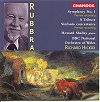 |
Symphony 1 and Sinfonia Concertante
CHANDOS
CHAN 9538 |
BBC Welsh SO/Richard Hickox
all recorded 1990s at the Brangwyn Hall, Swansea, Wales
(all full price and only available separately) |
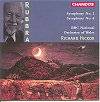 |
Symphonies 2 and 6
CHANDOS
CHAN 9481 |
 |
Symphonies 3 and 7 CHANDOS
CHAN 9634 |
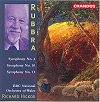 |
Symphonies 4, 10 and 11
CHANDOS
CHAN 9401 |
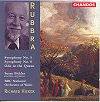 |
Symphonies 5 and 8
CHANDOS
CHAN 9714 |
 |
Symphonies 9 and Morning Watch CHANDOS
CHAN 9441 |
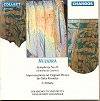 |
Symphony 10, Improvisation, Tribute CHANDOS
CHAN 6599 |
Bournemouth Sinfonietta/Schönzeler
recorded 1975 (mid price) |
| Other Works |
Some of this discs can no longer
be purchased. The reviews are included for reference and for those who like
searching out used copies. |
| Choral Works |
Magnificat & Nunc Dimittis, Tenebrae Nocturnes
, Salutation, Missa In Honorem Sancti Dominici
, Festival Gloria, Gloria Dei Patris |
Elizabeth C. Patterson. James Jordan (organ). Guild GDCD024
|
Songs |
Songs for Voice and harp: A
hymn to the Virgin Op13 no2: Rosa Mundi Op 2: The Mystery Op
4 no 1: Jesukin Op 4 no 2: Orpheus with his Lute Op 8 no2:
Song-Cycle The Jade Mountain Op 116 Solo harp works Fukagawa
(1929) Transformations Op 141 Pezzo Ostinato Op 102 Nocturne
by BERKELEY and Prelude by HOWELLS Harp and cello Discourse Op 127
Solo Cello Improvisation Op 124 |
Tracey Chadwell Soprano
Danielle Perrett harp
Timothy Gill cello
ASV CD DCA 1036 |
Sonatas |
Violin Sonatas No
1 (1930); No 2 (1932); No 3
(1968); Four Pieces Op 29; Variations on a Phrygian
Theme Op 105. |
Krysia Osostowicz (Violin)
Michael Dussek (Piano)
DUTTON CDLX 7101 |
| Chamber Music Vol 1 |
Violin Sonata
2 Op 31 (1932); Piano Trio 1
Op 68 (1950), Prelude and Fugue on a Theme by Cyril Scott
Op 6g (1950); Piano Trio 2 Op 138 (1970); Fantasy
Fugue Op 161. |
Michael Hill, piano;
Kate Bailey, violin;
Spike Wilson, cello;
Lyn Fletcher, violin (violin Sonata)
DERVORGUILLA
DRVCD 104 |
Concertos |
Concerto for Violin &
Orchestra Op 103; Concerto in A for Viola &
Orchestra Op 75 |
Tasmin Little, violin,
Rivka Golani, viola
RPO/Vernon Handley
CONIFER CDCF 225 |
Quartets |
String Quartets |
Sterling Quartet.
Conifer 75605 51260 2 |
CONCLUSIONS
The Hickox Chandos cycle is of great importance but mere importance can make
for the most lacklustre listening. As it is Rubbras music carries no shred
of dullness It is immediately identifiable, has a passionate unity of character,
emotional without excess, turbulent without cacophony and driven without
being chaotically splenetic.
This cycle stands high among the recorded cycles of twentieth century symphonic
music. It easily compels a place among the recorded symphonic cycles of
Tubin, Holmboe, Hanson, Rosenberg, Madetoja, Vaughan Williams, Bax,
Alwyn, Langgaard, Rosenberg, Shostakovich and Prokofiev. Miss these works
at peril of your own impoverishment. If you wish to acquire them gradually
then start with Nos 4, 10 and 11 then progress to 3 and 7, 5 and 8, 1 and
then 9.
© Rob Barnett

See also Francis Routh
on Rubbra
Note from Jim Brennan
Reading this collection of reviews, especially of the Hickox series,
reminds me of hearing the Halle, under Barbirolli, playing No 6 in
the Sheldonian at Oxford in the spring of 1956.
Rubbra was teaching in Oxford, then, and was sitting in the box over
the Ashmolean side-entrance to the Sheldonian, and sitting above and
nearly opposite him, i had a good view. His body language was uninhibited
and unambiguous. Virtually every beat brought an emphatic and positive
response, even the vaquero Hispanicisms of the trumpet tune in the
finale. He was clearly in favour of everything Barbirolli did. Which
is fascinating, because Barbirolli’s tempi, as was usual with
Rubbra at the time, and performances of Symphonies 4 and 5 were not
at all uncommon then, were by Hickox’s yardstick, fairly moderate.
I don’t think Hickox got the hang of No 6 at all. Norman Del
Mar, who must have played the horn in a fair few Rubbra symphonies
before he came to record for Lyrita, also takes a moderate view, though
not as moderate as Barbirolli. In fact, it turns out that on timing
Del Mar and Hickox are pretty close, though I still think Del Mar
does a better job. Beecham used to say that tempo was an illusion.
I also recall the Rubbra-Gruenberg-Pleeth trio, especially in a performance
of Brahms’s Op 87 in Balliol College Hall, with Rubbra, who had
the requisite octave technique and stamina, thoroughly enjoying himself.
Oddly, the last time I heard his music in public was a performance
of the one-movement piano trio in Inverness, by a trio from Aberdeen
University in which the pianist had been a Rubbra pupil, and knew
exactly what he was doing. The strength of the work impressed the
audience, to most of whom it must have been completely unfamiliar,
enormously.
What an odd period the forties and fifties were. Rubbra’s disdain
for orchestral colour and concentration on contrapuntal essentials
were entirely in tune with the utilitarian austerity of the time.
The end of rationing, and the Macmillan easing of consumer credit
swept all that away, and there were suddenly very few Puritans left.
The last time a Rubbra Symphony premiere attracted national attention
was no 7, which the critics of the time found Brahmsian, by then almost
as poisonous an adjective as it had been for GBS. He was never exactly
fashionable, but he didn’t deserve the neglect his later years
got.
Nice to see someone taking an interest
Jim Brennan
January 2009
